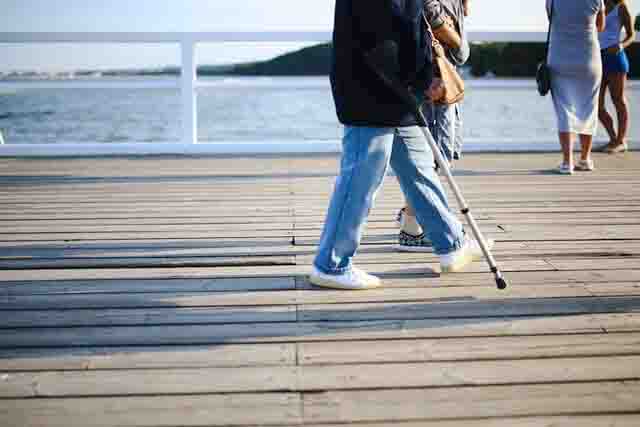Are you looking for the best crutches for your physical problem or your close one? If yes, then before buying any crutches you have to know the major tips of how to choose crutches?
Let’s find out what you should keep in mind to choose the best crutches that suit you the best.

How to Choose Crutches : Step by Step Guidelines
To ensure your stability and safety, you must learn how to choose crutches and What size crutches do you need?. Although there is a simple way to select crutches and that has some following steps
Step 1. Measure your forearm from 3 inches below the elbow.
Step 2. Add the distance between the floor and wrist.
Step 3. For the cuff size, measure the big part of the forearm.
Step 4. Based on your measurement, select a pair of crutches.
Step 5. To match your measurement adjust the length of the crutches.
Remember that if you don’t choose the correct size of crutches, the risk of further damage to your joints or other physical problem may increase. So don’t take any chance of doing a wrong measurement.
However, you must know about all of the following questions to answer how to choose crutches?
- When do you need crutches?
- What type of crutches is best?
- How to use crutches?
1. When do You Need Crutches?
You may have long-term and short-term injuries. If you have any of the following injuries, you should use crutches.
- Broken Ankle
- Knee Injury
- Muscle Strain
- Achilles Tendon Injury
- Hip Dislocation
- Broken Foot
- Stress Fracture
- Sprained Ankle
- ACL Injury
- Other Leg Injuries
2. What Type of Crutches is Best?
Basically, according to your injury types, you should decide what type of crutches are best for you.
Types of Crutches
- Underarm Crutches (also known as Axillary crutches)
- Forearm Crutches (also known as Elbow crutches)
Underarm Crutches
Usually, this type of crutches is used while recovering from leg injuries Broken Ankle, Sprained Ankle, etc. People of the United States used these crutches more than other country’s people. These crutches are readily available and easy to learn, and this makes them best for short-term use.
Although it is best for us, it can make your underarm, hand, and wrist sore because of the pressure exerted during the use of this crutch.
Pros
- It requires less upper body strength
- Easy to master
- Take less coordination
- Readily available
Cons
- Cause sore hands, wrist, and underarms
- Improper use may cause axillary nerve dysfunction.
Things to remember when using Underarm Crutches
- Before using, you should measure the crutches correctly to avoid further injuries and falls.
- Maintain 2 to 3 finger distance between the armpit and the crutch pad.
- Keep your elbow flexed at a 30-degree angle
- To prevent any damage to nerves, your body weight should be supported by the handgrips.
- To have a proper balance on the crutch, keep rest your crutch tips around 6 inches outside and 2 inches forward the feet.
Forearm Crutches
This is the right solution for, who want more comfortable crutches to use. It may help you to reduce your back pain and to maintain actual posture. The people of Europe and Canada are the common users of these crutches. Usually, forearm crutches are recommended for long-term disabilities, but you can also use them for the short term. It also the best option for permanent disabilities. As they offer significant freedom of movement, you can easily choose this one for comfortable use.
Pros
- Encourage actual posture
- Easy to use
- More comfortable with greater freedom of movement
Cons
- Need more upper body strength
- More difficult to master
Things to remember when using Forearm Crutches
- The crutch should be 2 to 4 inches to the side of the foot and about 6 inches in front of your foot.
- Should have wrist level height of handgrips
- You should adjust your cuff 1 inches below the elbow
- Your elbow will be the angle at 30 degrees if your height is adjusted correctly
However, you already get a clear idea that underarm crutches are easier to master, and forearm crutches may give you greater control over your movement. Now you can easily decide which would be the best option for you. As forearm crutches are allowed different gaits for different terrain, this is suggested for more active patients.
3. How to Use Crutches?
- Follow the proper instructions from a designated health expert.
- To reduce extra stress on the wrist, it would be best for you to transition slowly with crutches.
- For general weakness, you should use a four-point walking pattern.
- If your balance is insufficient, both of your crutches should put forward first. If your credit is good, you should swing the level of the crutches that will help you increase your fluency and speed.
- For climbing upstairs, you should lift your unaffected leg up to the first step and take your weight on the crutches, and on the second step, bring your affected leg with crutches.
- To go down first of all lower your affected leg and crutches down the step first and do the second step with your unaffected leg.
Frequently Asked Questions
What is Non Weight Bearing Crutches?
If you are suggested for non-weight bearing crutches by your physician, then you must keep your affected leg off the ground. If your weak leg can take no weight, first of all you should put forward both of your crutches, followed by a hop-forward of the strong leg, stop yourself behind the crutches and keeping your weak leg clear of the ground. On the other hand, if you have a strong balance, you can swing past the crutches that may help you raise your speed.
The non-weight bearing period is necessary for the proper healing of your tissue and bone.
However, for a non-weight bearing injury, underarm crutches are the best option.
Do You Need Crutches for a Sprained Foot?
No, you don’t need it at all, because early weight-bearing help sprained foot to heal quickly. In this situation, at first, you must keep rest your foot and limit your movement for 2 to 3 days. But you may need crutches if you take the weight off your weak foot as it heals.
Side Effect of Using Crutches Do Crutches Work Your Abs?
All of the following side effect you may face at the time of using crutches
- Skin Irritation
- Soreness
- May harm your nerve system
- Wrist or hand injury
- Artery injure
- Improved contact with Pad
- Keeping the underarm off the Pad
- Spreading Workaround
- Atrophy for lower body parts
- Simplifying the routine
How to Walk on a Sprained Ankle Without Crutches?
Before, walking you should get the permission of your doctor to walk with a sprained ankle. To avoid further damage to your leg, just follow all of the following tips to walk with your sprained ankle.
- After a sprain, your leg apply ice as soon as possible
- Try to walk normally
- After walking, keep resting your ankle to start its healing process.
- To relieve swelling and pain, you can take an anti-inflammatory medication.
- By reducing swelling speeds up your ankle healing process.
- Protect your ankle with bandage or high-top shoes
- Walk slowly by taking small steps
- Stop when need and put your weight to your strong foot.
- Practice different leg exercises to increase the strength of your ligaments.
- Raise your stability by balance yourself with your weak ankle.
Do You Need Crutches With a Walking Boot?
You don’t need any crutches with a walking boot, although you should not put weight on your walking boot.
Hopefully, you already learn the basic process of how to choose crutches with the perfect size for you. Don’t forget to follow the tips for how to use crutches. Please leave a comment if you have any questions?

I like to think positive about life. I always wanted to be a great writer, like Victor Hugo and Roman Roland, who have influenced millions of people through their books. I like to write an article on unique topics, where I try my best to provide important information that will meet the need of the people